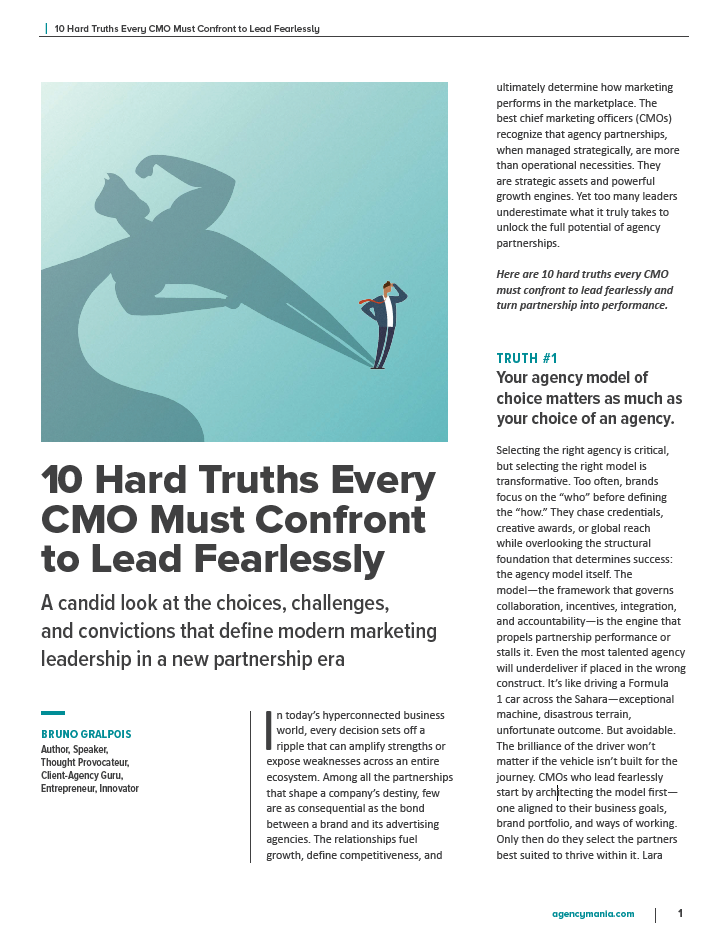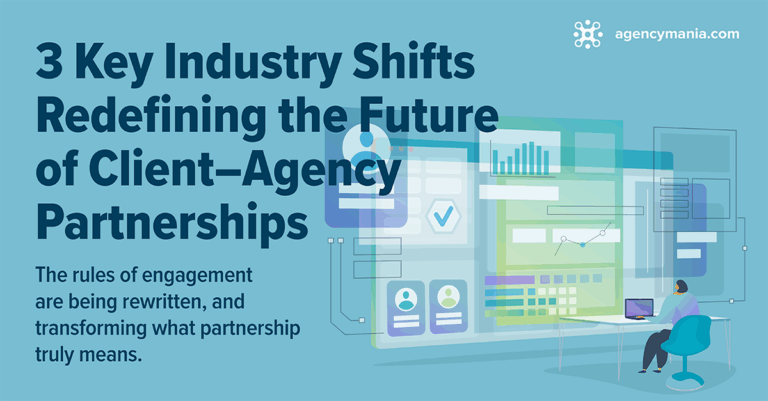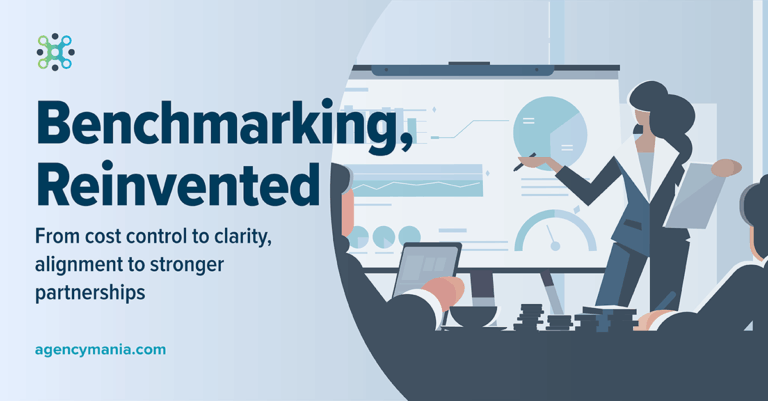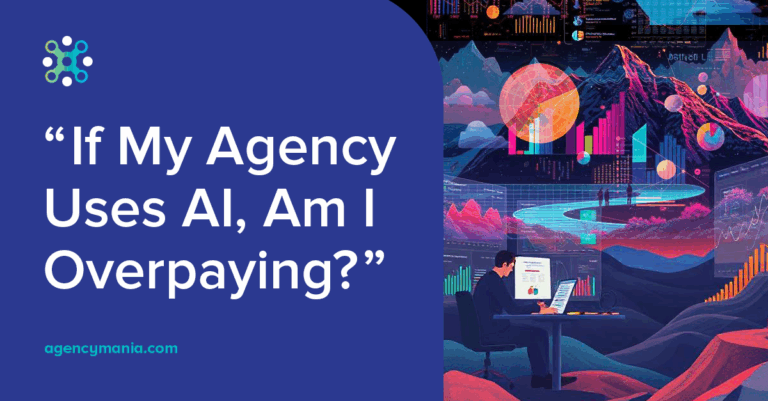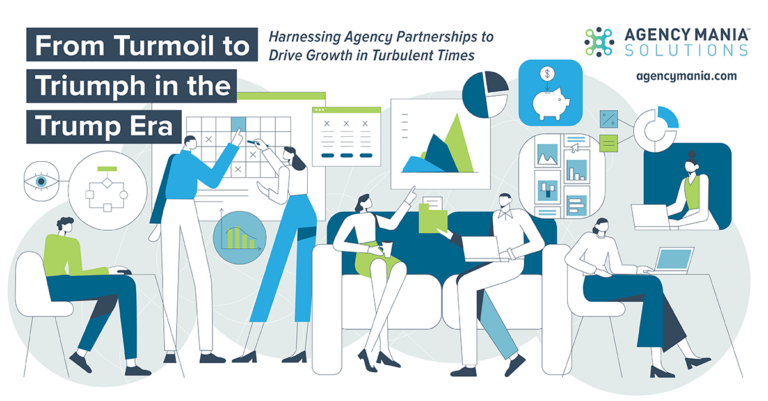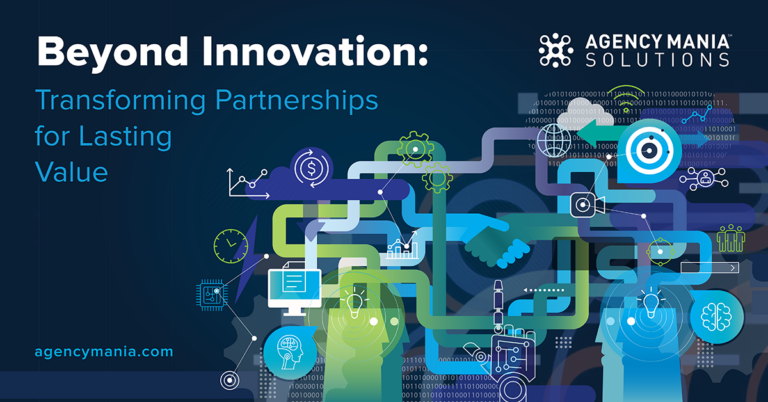A candid look at the choices, challenges, and convictions that define modern marketing leadership in a new partnership era
In today’s hyperconnected business world, every decision sets off a ripple that can amplify strengths or expose weaknesses across an entire ecosystem. Among all the partnerships that shape a company’s destiny, few are as consequential as the bond between a brand and its advertising agencies. The relationships fuel growth, define competitiveness, and ultimately determine how marketing performs in the marketplace. The best chief marketing officers (CMOs) recognize that agency partnerships, when managed strategically, are more than operational necessities. They are strategic assets and powerful growth engines. Yet too many leaders underestimate what it truly takes to unlock the full potential of agency partnerships.
Here are 10 hard truths every CMO must confront to lead fearlessly and turn partnership into performance.
1. Your agency model of choice matters as much as your choice of an agency.
Selecting the right agency is critical, but selecting the right model is transformative. Too often, brands focus on the “who” before defining the “how.” They chase credentials, creative awards, or global reach while overlooking the structural foundation that determines success: the agency model itself. The model—the framework that governs collaboration, incentives, integration, and accountability—is the engine that propels partnership performance or stalls it. Even the most talented agency will underdeliver if placed in the wrong construct. It’s like driving a Formula 1 car across the Sahara—exceptional machine, disastrous terrain, unfortunate outcome. But avoidable. The brilliance of the driver won’t matter if the vehicle isn’t built for the journey. CMOs who lead fearlessly start by architecting the model first—one aligned to their business goals, brand portfolio, and ways of working. Only then do they select the partners best suited to thrive within it. Lara Balazs, CMO of Adobe, highlighted this phenomenon so well: “For a long time, the CMO role, the role of the marketer, was about the stories we tell, the splash we make, the ROI we drive. We need to do that, but we’re being asked to step into a bigger role to be the chief transformation architects.” The model is the blueprint. The agencies are the builders. Get the blueprint wrong, and even the best craftsmanship won’t save the house.
2. If you measure what you treasure, then treasure what you measure.
Today’s CMOs sit atop an ocean of information: marketing performance dashboards, media reports, social sentiment, brand equity scores, ROI models, and more. Amid this data deluge, true leadership lies not in collecting more of it but in curating the right metrics. The most effective CMOs know that measurement is an act of prioritization: to measure what you treasure means zeroing in on the KPIs that reflect what truly drives enterprise value—growth, brand strength, customer loyalty, and partnership performance. Investing in the right KPI tracking systems, analytics tools, and integrated dashboards is no longer optional, it’s foundational. When insights are fragmented, decisions become reactive. By uniting marketing and agency performance data within a single source of truth, CMOs turn metrics into meaning and accountability into action. Ultimately, the CMOs who treasure what they measure build a culture of clarity and alignment, one in which data fuels purpose, not paralysis. What gets measured gets managed, and what gets treasured gets transformed.
3. Shift from time-based to outcome-based compensation—reward impact, not effort.
The clock can no longer be the currency of value. For decades, agencies have been paid for the time they spend, not the impact they create. According to the Association of National Advertisers’ Trends in Agency Compensation Report (19th edition, November 2025), 84% of major advertisers still rely on fee-based compensation models anchored in staffing plans, hourly rates, and overhead markups. But in an age in which AI is rewriting the speed of work, time is losing its meaning. What took days can now take minutes. The metric that once felt fair is quickly becoming flawed. As automation accelerates production, the real value shifts from how long something takes to how well it delivers and then performs. Brands want outcomes, not outputs. So agencies are investing heavily in AI talent, training, and tools to drive efficiency, precision, and creativity at scale. Under a traditional time-based model, such advancements ironically erode agencies’ revenue rather than reward their innovation. Outcome-based compensation restores balance and fairness. As Ramzi Chaabane, director of marketing indirect procurement at L’Oréal, stated, “Agencies will need to stop selling outputs and start selling outcomes.” The outcome-based model aligns incentives to what truly matters to marketers, which are results, growth, brand impact, and business performance. The future of partnership lies in valuing ideas that move markets. In this new era, impact—not time—is the ultimate measure of worth.
4. Use cost benchmarking as a carrot, not a stick—motivate, don’t intimidate.
Cost benchmarking, when done right, isn’t a weapon—it’s a window. In my article “Benchmarking, Reinvented,” I argue that benchmarking should fuel not only smarter negotiations but also stronger partnerships. Benchmarks provide a valuable lens—comparing proposed scopes and fees against historical performance or industry standards—to ensure fairness and transparency. Too often, benchmarking is misused as a blunt instrument, wielded to pressure agencies into conformity and drive prices ever lower. This race to the bottom erodes trust, stifles innovation, and punishes differentiation, the very qualities that make great partnerships thrive. True value isn’t born from fear; it’s inspired by mutual ambition. When advertisers use benchmarking as a carrot, they unlock its real power. It becomes a tool for understanding and quantifying value creation. Agencies can then use the data to highlight where they exceed norms—where their craft, innovation, and impact rise above the baseline. That’s when benchmarking transforms from a negotiation tactic into a shared incentive for excellence. Used wisely, it elevates both sides of the partnership, because progress drives performance.
5. Get comfortable being uncomfortable—growth lives on the edge of discomfort.
Great partnerships aren’t built in comfort zones. The most powerful client–agency relationships thrive in tension, because tension, when managed with trust, is the spark of progress. Agencies aren’t hired to echo agreement; they’re hired to challenge assumptions, question conventions, and push brands beyond what feels safe. Their job is to provoke, inspire, and elevate. In the film World War Z, Israel’s survival hinges on a bold idea called the “10th Man Rule.” Whenever nine people agreed on a course of action, the 10th was tasked with assuming they were wrong and exploring what the nine had missed. The 10th individual is the contrarian voice. That’s the essence of what agencies bring to the marketing table: the courage to see differently, to test what others take for granted, to protect brands from the blindness of consensus. Yes, this creates friction. But friction, when grounded in respect and shared ambition, sharpens ideas and accelerates growth. As Dominic Goldman, founder and CCO of You’re The Goods, stated, “We live by a simple motto: be hard on the work, kind to the people. Friction is part of that process.” The best CMOs welcome this dynamic. They understand that comfort breeds complacency and that discomfort, when constructive and purposeful, is where breakthrough thinking begins. Growth doesn’t happen in harmony; it happens in the heat of honest, challenging collaboration.
6. In today’s agency world, embrace that bigger no longer means better.
For decades, scale was power. The biggest holding companies wielded their size like a sword as they leveraged economies of scale and media buying muscle to secure prices that smaller players could only dream of. In the modern marketing era, size no longer guarantees strength. The game has shifted from buying power to data power, from volume to value, from reach to relevance. As personalization and precision replaced bulk buying, the advantage of bigness began to fade. Today’s CMOs aren’t chasing the biggest names; they’re chasing the sharpest minds. They’re partnering with smaller, more agile agencies that can pivot fast, innovate boldly, and operate without the bureaucracy that slows giants down. Speed, creativity, and adaptability have become the new currencies of success. Even industry leaders acknowledge the changing tide. Publicis Groupe Chairman and CEO Arthur Sadoun noted, “Consolidation of more of the same for the sake of efficiencies is basically yesterday’s logic.” His words echo a new reality: CMOs would rather move with agility than be anchored by scale. In a marketplace defined by disruption, dinosaurs don’t survive, the nimble do.
7. Aspire to greatness to attract greatness—excellence recognizes its own.
Over the years—first as a client, then as a technology and service partner—I’ve led countless performance evaluations between brands and agencies. The sessions were never just about judging the agency’s output; they were about examining the partnership. The most insightful CMOs ask, “How did we perform as a client?” instead of just “How did the agency perform?” Partnership is a two-way mirror: what you reflect is what you receive. Modern 360° evaluations embrace this truth. They reveal the interdependence between how clients lead and how agencies deliver. When clients cut budgets, rush timelines, or provide vague guidance, even the best agencies will struggle. Every action, or inaction, creates a domino effect on creativity, performance, and trust. Excellence, therefore, starts at the top. CMOs who demand world-class work must model world-class partnership. When clients demonstrate clarity, respect, and ambition, agencies rise to meet them. Greatness attracts greatness, and only those who embody excellence can truly inspire it in others. In a nutshell, if you want an amazing partner, you yourself must be that partner.
8. You can’t shrink your way to growth—invest where it matters most.
In uncertain times, every marketing dollar feels heavier. CMOs are right to be prudent. Discipline and accountability matter. But prudence is not the same as paralysis. You can’t cut your way to greatness, and you can’t starve your partners and expect them to thrive. True growth comes from investing boldly and wisely in the areas that create the most value. Under financial pressure, too many brands focus on trimming what’s most visible: agency fees. Procurement often calls it “efficiency.” However, without the proper foundation—clear scopes, disciplined resource alignment, and transparent performance data—the cuts can become self-defeating. Reduce too far, and you erode the very partnership that drives differentiation, creativity, and long-term growth. When agencies are forced to downsize teams or downgrade talent, quality declines, morale fades, and attention shifts to clients who invest with purpose. Smart CMOs understand this equation. They treat their agencies as growth partners and co-investors in impact. So how do you shift from penny-pinching to partnership-building? Visionary CMOs know that strong agencies aren’t the problem to be fixed—they’re the partners to be empowered. By funding the relationship, not just the deliverables, they build a foundation of trust, performance, and shared accountability. When treated as allies, agencies become powerful co-architects of cost efficiency, innovation, and responsible growth.
9. Follow the Platinum Rule: treat others the way they want to be treated.
The Golden Rule teaches us to treat others as we wish to be treated. The Platinum Rule goes further—treat others as they wish to be treated. In the complex world of client–agency relationships, that distinction makes all the difference. Brands and agencies are not meant to be identical; their strength lies in their contrast, in how their complementary skills, cultures, and perspectives combine to create something greater than either could achieve alone. The most effective CMOs understand that assumptions kill alignment. They don’t presume to know what motivates their agencies—they ask. They take the time to understand what their partners truly value. It might be creative freedom, meaningful recognition, exciting work, or the opportunity to grow and learn. Profit and awards matter, yes, but fulfillment, trust, and purpose often matter more. Even within the same agency, motivations differ by team or leader. Justin Thomas-Copeland, CEO of the 4As, said it best: “Clients and CMOs should know that we are focused on gearing agencies up not just to deliver value, but to reimagine that value. Because we know that business is changing. We know the rules are changing, the expectations are changing.” That’s why the best CMOs make listening a discipline. Through business reviews, structured performance evaluations, and candid, regular check-ins, they continually recalibrate expectations. The Platinum Rule transforms partnerships from transactional to transformational. When you honor how your partners want to be treated, they’ll deliver what you never thought possible.
10. Improve your scope to give agencies the right rope—to excel, not hang.
The single greatest determinant of agency success isn’t talent or technology. It’s guidance. Clear, timely, and actionable direction from clients is the lifeline of every effective partnership. Yet too often, brand advertisers struggle to provide guidance with enough precision, context, or lead time. Plans shift, priorities evolve, and agencies are left guessing. The result? Confusion replaces clarity, rework replaces momentum, and opportunity slips away. Strong CMOs know that great work begins with great scoping. The budgeting and planning process is the foundation. When agencies have visibility into what’s coming, they can secure the right talent, plan resources intelligently, and focus energy where it drives the most impact. Done well, scope-of-work management turns chaos into coordination and ensures that funding, timing, and expectations are fully aligned. The best CMOs make scoping a collaborative act, not a clerical one. They empower teams to define deliverables, timelines, and costs together with their agencies, then track progress, reconcile budgets, and adjust as business realities evolve. When agencies are guided with clarity, they deliver and elevate. Give them the right rope, and they’ll climb higher than you imagined.
Conclusion: Partnership Is the Ultimate Growth Strategy
The modern CMO’s challenge is orchestrating partnerships that amplify value, creativity, and performance in a world that never stops changing. The 10 truths I’ve outlined comprise a manifesto for fearless leadership in marketing. Each truth reminds us that partnership is a living system: it thrives on trust, alignment, and shared ambition, and collapses under complacency. CMOs who master these dynamics transform agency relationships from transactional to transformational. While demanding excellence, they also inspire it. They design smarter models, measure what matters, reward impact, and invest in the people and processes that move brands forward. In the end, growth comes from building partnerships that elevate everyone involved. Lead with purpose. Collaborate with courage. And remember, great partnerships aren’t managed—they’re inspired.
Author, Speaker, Thought Provocateur, Client-Agency Guru, Entrepreneur, Innovator

